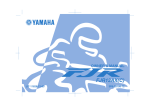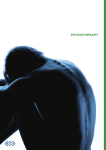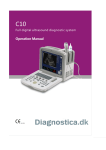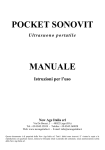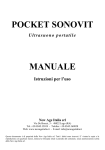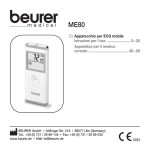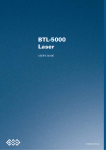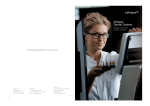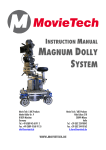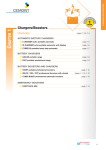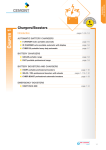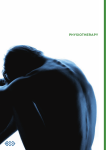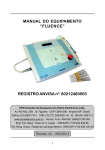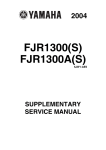Download - Frank`s Hospital Workshop
Transcript
BTL-2000 Series USER’S MANUAL & USERS’S GUIDE v501z9PL27/07/2006EN BTL-2000 USER'S MANUAL & USER’S GUIDE Index 1 GENERAL CHARACTERISTICS ........................................................................................................................... 4 2 USER MANUAL ..................................................................................................................................................... 5 2.1.1 2.1.2 2.1.3 2.2 2.3 2.4 2.4.1 2.5 2.5.1 2.5.2 2.5.3 2.5.4 2.5.5 2.5.6 2.5.7 2.6 2.7 2.8 2.8.1 2.8.2 2.8.3 2.8.4 2.8.5 2.8.6 2.9 2.9.1 2.9.2 2.9.3 2.9.4 2.9.5 2.10 2.10.1 2.11 2.11.1 2.11.2 2.11.3 2.11.4 2.12 2.13 2.13.1 2.13.2 2.13.3 2.14 2.15 2.16 2.16.1 2.16.2 3 TECHNICAL PARAMETERS ............................................................................................................................... 28 3.1 3.2 3.3 3.4 4 Outward Appearance ................................................................................................................................. 6 Functions of Push buttons, Connectors, and Display. ................................................................................ 6 Basic Operation Procedures ...................................................................................................................... 6 Instrument Assembly and Initiation............................................................................................................. 7 Starting Operation ...................................................................................................................................... 7 Medical Field Selection (push button [DIAG])............................................................................................. 8 User diagnoses .......................................................................................................................................... 8 Adjusting therapy parameters..................................................................................................................... 9 Density ....................................................................................................................................................... 9 Irradiated Area ........................................................................................................................................... 9 Power ......................................................................................................................................................... 9 Frequency ................................................................................................................................................ 10 Nogier (Frequencies according to Dr. Nogier) .......................................................................................... 10 EAV (Frequencies according to Dr. Voll).................................................................................................. 10 Medical Fields .......................................................................................................................................... 11 Programme selection (push button [PROG]) ............................................................................................ 12 Manual setting (push button [MAN]) ......................................................................................................... 12 User menu (push button [MENU]) ............................................................................................................ 13 Patient search .......................................................................................................................................... 13 Patient List ............................................................................................................................................... 14 User diagnoses ........................................................................................................................................ 15 System Setup ........................................................................................................................................... 17 Acupuncture ............................................................................................................................................. 21 PROBE TEST: Optical Power of Probe.................................................................................................... 22 Therapy .................................................................................................................................................... 23 Display during therapy.............................................................................................................................. 23 To start therapy ........................................................................................................................................ 23 To interrupt therapy .................................................................................................................................. 23 To Continue Therapy................................................................................................................................ 23 To terminate therapy ................................................................................................................................ 23 Power Supply: Mains and Battery............................................................................................................ 23 Sparing Batterires..................................................................................................................................... 24 Optical Attachments ................................................................................................................................. 24 Dentistry Attachment ................................................................................................................................ 24 Gynaecological Attachment...................................................................................................................... 24 ENT Attachment....................................................................................................................................... 24 Positioning an Attachment........................................................................................................................ 25 Maintenance............................................................................................................................................. 25 Safety of Instrument ................................................................................................................................. 25 Remote control ( DOOR )......................................................................................................................... 25 Use of Safety Accessories ....................................................................................................................... 25 Safety Warnings ....................................................................................................................................... 26 Useful addresses...................................................................................................................................... 27 Warranty................................................................................................................................................... 27 Accessories.............................................................................................................................................. 27 Standard Accessories .............................................................................................................................. 27 Additional Accessories ............................................................................................................................. 27 Technical parameters BTL-2000 .............................................................................................................. 28 Basic parameters of laser generator ........................................................................................................ 30 Technical parameters of laser probes ...................................................................................................... 30 Technical parameters ADAPTER BTL-282 .............................................................................................. 31 USER’S GUIDE .................................................................................................................................................... 32 4.1 4.2 4.3 4.3.1 4.3.2 4.3.3 4.3.4 4.3.5 Introduction .............................................................................................................................................. 32 Light; the principle of laser light and its specifics...................................................................................... 32 Types of lasers ......................................................................................................................................... 33 Source...................................................................................................................................................... 33 Wavelength (primarily semi-conductor lasers).......................................................................................... 33 Operation mode........................................................................................................................................ 34 Type of beam ........................................................................................................................................... 35 Laser class (defined by the output) .......................................................................................................... 35 Page 2 of 46 BTL-2000 4.3.6 4.4 4.5 4.6 5 5.1 5.2 5.3 5.4 5.5 5.6 5.7 5.8 5.9 5.10 5.11 USER'S MANUAL & USER’S GUIDE Use........................................................................................................................................................... 35 Basic physical quantities .......................................................................................................................... 35 Biologic effects of a low-output laser (non-invasive laser) ........................................................................ 35 Contradictions of non-invasive laser therapy............................................................................................ 36 LIST OF THERAPIES........................................................................................................................................... 37 Dentistry (Medical Field 03)...................................................................................................................... 37 Dermatology (Medical Field 04)................................................................................................................ 37 Gynaecology (Medical Field 05) ............................................................................................................... 38 E.N.T. (Medical Field 06).......................................................................................................................... 38 Rehabilitation (Medical Field 07) .............................................................................................................. 39 Neurology (Medical Field 08).................................................................................................................... 40 Orthopaedics (Medical Field 09)............................................................................................................... 40 Sports Medicine (Medical Field 10) .......................................................................................................... 41 Pediatrics (Medical Field 11) .................................................................................................................... 41 General Practitioner (Medical Field 12) .................................................................................................... 41 Acupuncture ............................................................................................................................................. 42 6 APPENDIX A ........................................................................................................................................................ 43 7 APPENDIX B ........................................................................................................................................................ 44 Page 3 z 46 BTL-2000 1 USER'S MANUAL & USER’S GUIDE GENERAL CHARACTERISTICS BTL-2000 is a portable therapeutic laser that employs red and infrared BTL laser probes of various powers. BTL-2000 is designed for easy use and is understandable even for those who are new to laser technology. The laser beam irradiation strength is easy to regulate. Parameters can easily be changed as desired and your own programmes can be created and saved. BTL-2000 software allows continuous change of frequency, density, power, area and time. Considering all parameters are correlated, when a parameter is changed the instrument automatically recalculates the remaining parameters. BTL-2000 provides preset programmes for the following medical fields: rehabilitation, orthopaedics dentistry, gynaecology, neurology, dermatology, ENT, sports medicine, paediatrics, and general practice. The use of the preset programmes can significantly speed up therapy. When a field and diagnosis is chosen, the instrument will automatically set up the therapy parameters. BTL-2000 excels with its high power and operates in both Continuous and Pulse modes. In the pulse mode it is possible to modify the DUTY FACTOR of output frequency in the range of 10–90 %. BTL-2000 enables the user to precisely determine the necessary probe distance from skin by setting the desired therapy surface area. BTL-2000 automatically tests laser probe performance and corrects the power for optimal laser output. BTL-2000 is compatible with both digital and analog probes. BTL-2000 is especially suitable for acupuncture treatment. BTL-2000 has two modes for easy and percise location of acupuncture points. While the instrument measures the changes in skin resisitivity, visual and accoustic signals indicate acupuncture point locations. The instrument is also pre-programmed with Nogier and EAV frequencies. For dentistry, gynaecology and ENT special optical attachments enable the laser to treat difficult to reach places. The optical attachments are easily attatched to the probe and ready for use. BTL-2000 complies with all internationally recognised laser instrument specifications. Page 4 z 46 BTL-2000 2 USER'S MANUAL & USER’S GUIDE USER MANUAL Upper Panel, Front Panel, Lower Panel 1 2 3 4 5 11 6 7 12 8 9 10 13 14 16 15 Page 5 z 46 BTL-2000 2.1.1 USER'S MANUAL & USER’S GUIDE Outward Appearance BTL-2000 is housed in a metal varnished box. Weight and measurements are described in Technical Parameters 3. The lighted LCD display and push buttons are located on the front panel. Laser probe connector and mains power switch are located on the upper panel. Connector for mains power/recharge adapter (CHARGE) cable, acupuncture probe connector (ACUPUNCTURE), connector for remote blocking (REMOTE CONTROL) and input for measuring laser power (PROBE TEST) are located on the lower panel. Voltage converter switch (115/230) and mains power plug are located on the mains power adapter (BTL-282). Manufacturer label and product label are located on the rear panel of the instrument case and mains power adapter. Warning labels are located on the rear and upper panels of the instrument case and on the laser probe. 2.1.2 Functions of Push buttons, Connectors, and Display. 1. 2. 3. 4. 5. 6. 7. 8. 13. 14. 15. 16. Mains Power Switch Laser Probe Output LCD display [DIAG] push button enters Medical Field Menu. [PROG] push button enters Preset Programme Menu. [MAN] push button sets therapy parameters for manual programming. [MENU] push button returns instrument to System Menu. [TAB] push button moves cursor to right when entering Safety Code, selects parameter settings [MAN], and moves cursor between medical field number and diagnosis number [PROG]. [ENTER] push button confirms selection, setting changes and safety code. [ESC/STOP] push button terminates therapy, starts/stops timer, and returns display to previous setting. [ + ] push button increases parameter values, selects settings, and moves cursor to the right. [ - ] push button decreases parameter values, selects settings and moves cursor to the left deleting previous character. Connector for mains power/ recharge adapter cable (CHARGE). Probe Test: Laser Optical Power Meter (TEST). Acupuncture Probe Input (ACUPUNCTURE). Remote Control Connector (DOOR). 2.1.3 Basic Operation Procedures 9. 10. 11. 12. BTL 2000 is controlled by means of an interactive menu. Press the [ + ] or [ - ] push buttons to move between menu settings. The selected setting is indicated by an arrow in the display’s left margin. The presence of an additional arrow indicates that the menu exceeds four lines when selecting the last setting on the display. Press [ENTER] to confirm selected setting. Press [ESC/STOP] to return to previous menu. TAB UVWXYZ The lower margin of the push buttons contains a set of letters. For entering letters, choose the desired letter by the number of push button presses relative to the placement of that character on the push button. For example in the figure above, U is entered by pressing the [Tab] push button once, V is entered by pressing the [Tab] push button twice, etc.. 11 characters can be entered using each lettered push button. For entering non letter characters, choose the desired character by the number of push button presses relative to the placement of that character in the table below. For example in the figure below, “ ! “ is entered by pressing the [Tab] push button nine times, “ ? “ is entered by pressing the [Tab] push button ten times, etc.. Page 6 z 46 BTL-2000 USER'S MANUAL & USER’S GUIDE DIAG PROG MAN MENU A F K P B G L Q C H M R D I N S E J O T 1 3 5 7 2 4 6 8 . + ( @ , ) # : * < $ ; / > & TAB U V W X Y Z 9 0 ! ? ´ For entering sentences (name, diagnosis, etc.) the [ + ] push button moves cursor to the right, acting as a spacebar, and the [ - ] push button moves the cursor to the left deleting previous characters. 2.2 Instrument Assembly and Initiation Carefully unpack instrument and place on a sturdy and level surface (max. 15° angle). Place in cool, dry environment out of reach from direct sunlight. Instrument generates heat when in use therefore it should not be placed in the vicinity of other heat generating devices. This may cause overheating of instrument. The instrument is cooled by natural air convection. Do not cover instrument with flammable materials. Do not place instrument in proximity of devices that emit strong eletric, magnetic, or electro-magnetic fields (motors, transformers, X-rays, etc.). This can cause electromagnetic interference. In case of any misunderstanding, please contact your BTL service representative. Connect the laser probe to the output connectors (2) according this way: The cable connector put in and secure the fluted ring by pressing and turning in the clockwise. ATTENTION AT THE CONNECTOR DISCONNECTING, first of all it is necessary to take by the fingers the fluted ring NO WHOLE connector. TURN BY THE FLUTED RING IN THE ANTICLOCKWISE and then after releasing of the ring disconnect the connector by the pulling, fluted ring still hold in the fingers! ATTENTION!!! DO NOT TURN THE WHOLE CONNECTOR BY THE FORCE, THE DEVICE CAN BE DAMAGED. Before the INITIAL turning on of instrument, check the Voltage Converter located on the adapter to insure it is in the correct position and in accordance with the mains voltage parameters. Voltage coversion is further described in the chapter Maintenance 2.12. In case of any misunderstanding, please contact your BTL service representative. We recommend proper storage of the instrument box in case additional transport of instrument is necessary. The instrument applies irradiation only, it does not apply any pharmaceuticals or substances. Connecting instrument (DOOR connector on the lower panel) with the door contact is recommended. For further information see Safety 2.13. The power will be ON following the pressing of the mains power switch on the upper panel. When the battary is low, a “Low battery“ warning will be signalled on the display. It is then necessary to connect the mains power adapter to recharge the battery. When turning the instrument on you MUST NOT press any buttons on the front panel. This will generate the error sign “Error 100 – Keyboard button jammed”. It is then necessary to turn off the instrument for minimum of three seconds to allow it to reset. (See NOTE). It is now necessary to enter a code to unlock the instrument. The manufacture code is preset as 0000. If it is not modified you can continue by pressing the [ENTER] push button. It is possible to change the code using the instructions in the chapter User diagnoses 2.4.1. Once the accurate code has been entered, the display shows th main menu. If there are any other reactions after the turning on of the instrument do not attach laser probe and contact BTL service technician before further use. NOTE: After turning the instrument on and before the entering of the code, the instrument is testing its internal functions (∼ 0.5 sec.). If the instrument finds an internal problem, you will see the error notice “Error“ and the instrument will then be locked in Safe Mode. In this case, it is necessary to contact your BTL service representative. If the error notification “Error 100 – Keyboard button jammed“ is displayed, it is either an operating error or it is possible a button is jammed. In the second case, try to release the affected button or contact your BTL service representative. 2.3 Starting Operation Switch the instrument on by pressing the power switch on the upper panel. Enter the safety code on initial screen. BTL-2000 Page 7 z 46 BTL-2000 USER'S MANUAL & USER’S GUIDE THERAPEUTIC ENTER CODE: LASER 0000 Using the [ + ] and [ - ] arrows, insert the safety code. Use the [TAB] push button to move cursor to the next position. Once the code has been entered, press the [ENTER] push button. The manufacture code is preset as 0000. Press the [ESC/STOP] push button to delete inserted values and to return to the first position. If the code is entered correctly, the display will show menu which can be preset using the [Sart with] function. If the code is not correct, the cursor will move to the first position of the code. BTL-2000 UNIVERSAL DIAG MAN PROG MENU Use the relative push buttons on the instrument front panel to select from the four programmes on the Main Menu. 2.4 Medical Field Selection (push button [DIAG]) When pressing the [DIAG] push button the instrument will enter the Medical Field Menu and it is then possible to select a preset medical field, Acupuncture frequency (Nogier or EAV), or user created programmes. According to user specialization, there is only one medical field pre-programmed in the instrument. Additional medical fields are available but not included. User diagnoses Nogier EAV Dentistry Dermatology Gynaecology ENT Rehabilitation Neurology Orthopaedics Sports medicine Paediatrics General Practitioner Example of medical field menu: >U N E D s o A e er diagnoses gier V ntistry Use the [ + ] or [ - ] arrows to move between medical fields and press the [ENTER] push button to select desired medical field. Press the [ESC/STOP] push button to return to the previous menu. 2.4.1 User diagnoses This setting allows searching for and selecting a user diagnoses with preset therapeutic parameters. If there are no user diagnoses in the memory, “Memory free” will appear on the display. If there are less than 6 user-created diagnoses in memory, a list of these diagnoses in alphabetical order will appear on the display. If there are 6 or more user-created diagnoses in memory, the following diplay will appear: USER DIAGNOSES Page 8 z 46 BTL-2000 USER'S MANUAL & USER’S GUIDE First char: _ Enter the first letter of desired diagnosis name and press the [ENTER] push button to enter the list of diagnoses. Use the [ + ] and [ - ] arrows to move between diagnoses names and press the [ENTER] push button to select desired diagnosis. After selecting desired diagnosis, preset therapy parameters will be displayed. Press the [ESC/STOP] push button to return to previous menu. D F A T e r r i n e e m s. _0 quenc a 1.0 e 1:3 .9J/cm 2 y 6.36Hz cm 2 Pwr 30mW 9 Ready 2 Density shows set irradiation density value (J/cm ) Frequency shows set frequency (Hz) 2 Area shows set area of irradiated area (cm ) Power shows set laser beam output (mW) Time shows set therapy duration (min/sec) Use the [ + ] or [ - ] arrows to adjust therapy parameters. Use the [TAB] push button to move between parameters. Start therapy by pressing the probe push button. For saving the adjusted parameters use the [MENU] push button to enter patient file or user diagnoses file. Use the [ESC/STOP] push button to return to previous menu. 2.5 Adjusting therapy parameters When adjusting preset therapy parameters, use the [MENU] push button to enter patient files, diagnoses, or user settings. 2.5.1 Density When the density is adjusted, the instrument automatically recalculates therapy time and power parameters. 2.5.2 Irradiated Area When using a divergent probe, use the following table for the probe distances from skin: Irradiated area [cm2] 0.5 1 1.5 2 2.5 3 Distance of probe from skin [cm] 1.5 2 2.5 3 3.5 4 When using a divergent probe, depth of penetration changes according to the distance of the probe from skin and it is necessary to deduct the desired depth of penetration from the displayed distance of probe. When using a convergent probe, distance of the probe from the skin is not a crucial factor. The distance is not measured because the beams are parallel. 2.5.3 Power When the power is adjusted, the instrument automatically recalculates the duration of exposure. Power value could be adjusted within range 20% to 100% of maximal probe output. Output power and the duration of therapy has an inverse relationship. An increase in power output will result in a decrease in therapy duration. Density will remain the same. Page 9 z 46 BTL-2000 USER'S MANUAL & USER’S GUIDE The instrument calculates output power in tenths of mW, but the display only shows whole numbers. Maximum and minimum power depends on the type of probe used, preset density and area. 2.5.4 Frequency When the frequency is adjusted, the instrument automatically recalculates therapy time and power parameters. BTL-2000 offers pre-programmed EAV and Nogier frequencies. 2.5.5 Nogier (Frequencies according to Dr. Nogier) After entering Nogier freqencies, the list of frequencies will be displayed. Use [ + ] and [ - ] arrows to move between the frequencies. Press the [ENTER] push button to select required frequency. Press the [ESC/STOP] to return to previous menu. >U A B C 1 2 4 9 . . . . 1 2 5 1 4 8 6 2 H H H H z z z z When required frequency is selected, therapy parameters will be displayed: D F A T e r r i n e e m s. _2 quenc a 1.0 e 1:2 .0J/cm 2 y 1.14Hz 2 cm Pwr 30mW 3 Ready Use the [ + ] and [ - ] arrows to adjust therapy parameters. Use the [TAB] push button to move between therapy parameters. Density and area values are preset. Frequencies can be modified only in the range of Nogier’s frequencies. Power and time are automatically recalculated. Start therapy by pressing probe push button. 2.5.5.1 Table of frequencies for laser acupuncture according to Dr. Nogier Frequency [Hz] U 1.14 A 2.28 B C D E F G 2.5.6 4.56 9.12 18.3 36.5 73.0 146.0 Use and Application Area Universal – whole body Chaotic changes – tissues and transitional epithelium, body openings (mouth, nose, eyes, …) Nutritive effect – chest and abdominal cavity Mesenchyma – limbs, gluteal area, muscles and ligaments, kidneys, genitals Metabolism – joints of cerebral symmetric organs Nerve tissue –peripheral parts of spine, back and top parts of head and neck Psychosomatic disorders – subcortical areas, lower parts of the face Emotional diseases – brain cortex, nervous system, frontal and temporal parts of head, lateral parts of nose EAV (Frequencies according to Dr. Voll) After entering EAV, a list of frequencies will be displayed. Use the [ + ] and [ - ] arrows to move between the frequencies. Press the [ENTER] push button to select required frequency. Press the [ESC/STOP] push button to return to previous menu. When required frequency is selected, therapy parameters will be displayed: D F A T e r r i n e e m s. _2 quEnc a 1.0 e 1:2 .0J/cm 2 y 1.70Hz 2 cm Pwr 30mW 3 Ready Use the [ + ] and [ - ] arrows to adjust therapy parameters. Use the [TAB] push button to move between therapy parameters. Density and area values are preset. Frequencies can be modified only in the range of EAV frequencies. Power and time are automatically recalculated. Start therapy by pressing probe push button. Press the [ESC/STOP] push button to return to previous menu. Page 10 z 46 BTL-2000 2.5.6.1 Table of EAV frequencies EAV (according to Dr.Voll) Frequency [Hz] 1.20 1.70 1.75 2.20 2.45 2.50 2.65 2.90 3.30 3.50 3.60 3.80 3.90 4.00 4.90 5.55 5.80 5.90 6.00 6.30 6.80 7.50 7.70 8.25 9.20 9.35 9.40 9.45 9.50 9.60 9.70 10.00 2.5.7 USER'S MANUAL & USER’S GUIDE Use and Application Area Tachycardia Abscess, furunculosis Psychostimulative and sympaticostimulative effect Fatigue, lipothymia, exhausting, restlessness, melalgia Haematoma, oedema, excessive menstrual bleeding due to myoma, haemorrhage of varices, sleeplessness, autonomic disorders, sinusitis Distorsion, vegetative dystrophia Gallbladder dystonia, periostitis Rhinitis Arteriosclerosis, arteriosclerotic hypertension Lithiasis, renal colic, tremor, melancholia Sleeplessness, excitability Spasms, glossodynia Neuralgia, depression, insomnia Disorders of pancreas, endocrine disorders, menorrhagia, headaches,dizzeness Dysmenorhea, stiff neck Angiospasm with paresaesthesia Fear, dizzeness, headaches Spastic paralysis Parasympatikotoic effect, hypertension, spastic stiff neck Excitability, headaches Myotonia Neuralgia n. trigemini Spastic paralysis Paralysis Eczema due to renal insufficiency, diastolic hypertension, renal insufficiency Paralysis Cystitis, disorders of prostate, disordes of colon, bronchitis, eczema due to disorders of lungs or vessles, gout, joint ache, gastric disorders (including ulcer), parsis, varices, haemorrhoids Tonsillitis, angina pectoris, disorders of hypophysis and gonads Spastic hypertension, climacteric hypertension, laryngitis, migraine Arthritis, rheumatism, rachiopathies Ischialgia, rheumatism Flebitis, ulcus cruris Medical Fields After entering the required medical field, the following menu will be displayed: DENTISTRY First char: _ Enter the first letter of desired diagnosis name and press the [ENTER] push button to enter the list of diagnoses. Use the [ + ] and [ - ] arrows to move between diagnoses names and press the [ENTER] push button to select desired diagnosis. After selecting desired diagnosis, preset therapy parameters will be displayed. Press the [ESC/STOP] push button to return to previous menu. Page 11 z 46 BTL-2000 USER'S MANUAL & USER’S GUIDE D F A T e r r i n e e m s. _2 quenc a 1.0 e 1:2 .0J/cm 2 y 5.00Hz 2 cm Pwr 30mW 3 Ready Use the [ + ] and [ - ] arrows to adjust therapy parameters. Use the [TAB] push button to move between therapy parameters. Start therapy by pressing probe push button. Press the [ESC/STOP] push button to return to previous menu. 2.6 Programme selection (push button [PROG]) When pressing the [PROG] push button the instrument will enter the Preset Programme Menu. It is then possible to select a preset therapy programme. A progamme number consists of a medical field number (first two numbers) and a diagnosis number (second two numbers). P A D F r c e r o n n e g 0400 e s. 0.4J/cm 2 quency 5.50Hz Use the [ + ] and [ - ] arrows to set desired programme number. Use the [TAB] push button to move between the medical field number and diagnosis number. Press the [ENTER] push button to enter therapy parameters of desired programme. Press the [ESC/STOP] push button to return to previous menu. When the desired programme has been entered, therapy parameters will be displayed. D F A T e r r i n e e m s. _0 quenc a 1.0 e 0:3 .4J/cM 2 y 5.00Hz 2 cm PwR 16mW 0 Ready Use the [ + ] and [ - ] arrows to adjust therapy parameters. Use the [TAB] push button to move between therapy parameters. Start therapy by pressing the probe push button. Press the [ESC/STOP] push button to return to previous menu. 2.7 Manual setting (push button [MAN]) When pressing the [MAN] push button, the instrument will enter the Therapy Prameters Menu and it is then possible to set therapy parameters manually. D F A T e r r i n e e m s. _1 quenc a 1.0 e 0:3 .0J/cm 2 y Continual 2 cm Pwr 30mW 3 Ready Use the [ + ] and [ - ] arrows to adjust therapy parameters. Use the [TAB] push button to move between therapy parameters. Start therapy by pressing the probe push button. Press the [ESC/STOP] push button to return to previous menu. Page 12 z 46 BTL-2000 2.8 USER'S MANUAL & USER’S GUIDE User menu (push button [MENU]) When pressing the [MENU] push button, the instrument will enter the System Menu and it is then possible to select from the following list. Patient search Patient list User diagnoses System setup Acupuncture Probe test >P P U S a a s y t t e s ient ient r dia tem s s l g e e i n t a s a u rch t ses p Press the [ + ] or [ - ] arrows to move between displayed settings. Press the [ENTER] push button to select desired setting. Press the [ESC/STOP] push button to return to previous menu. 2.8.1 Patient search Enter Patient Search when searching for patient file with saved therapy parameters. If there is no patient file in memory, “Memory free” will be shown on display. If there are less than 6 patient files in memory, a list of these patient files in alphabetical order will appear on the display. If there are 6 or more patient files in memory, the following menu will be displayed: PATIENT First LIST char: _ Type the first letter of desired patient name and press the [ENTER] push button to enter the list of patients. Use the [ + ] and [ - ] arrows to move between patient names and use the [ENTER] push button to select desired patient. After selecting desired patient, patient therapy parameters will be displayed. D F A T e r r i n e e m s. _0 quenc a 1.0 e 1:3 .9J/cm 2 Y Continual Cm 2 Pwr 30mW 9 Ready Use the [ + ] and [ - ] arrows to adjust therapy parameters. Use the [TAB] push button to move between therapy parameters. Start therapy by pressing the probe push button. Press the [ESC/STOP] push button to return to previous menu. Page 13 z 46 BTL-2000 2.8.2 USER'S MANUAL & USER’S GUIDE Patient List When entering Patient List, the following list will be displayed: >New patient Edit patient Delete patient Use the [ + ] and [ - ] arrows to move between displayed settings. Press the [ENTER] push button to select desired file. Press the [ESC/STOP] push button to return to previous menu. 2.8.2.1 New Patient When creating a new patient, enter New Patient by using the [ENTER] push button. After entering New Patient, the following menu will be displayed: Patient name: _ Enter the patient name and press the [ENTER] push button to save it in memory. After pressing the [ENTER] push button, the therapy parameters will be displayed. D F A T e r r i n e e m s. _0 quenc a 1.0 e 1:3 .9J/cm 2 y Continual 2 cm Pwr 30mW 9 Edit Use the [ + ] and [ - ] arrows to adjust therapy parameters. Use the [TAB] push button to move between therapy parameters. Press the [ENTER] push button to save adjusted data. After pressing the [ENTER] push button, “Data saved“ will be shown on the display. Press the [ESC/STOP] push button to return to previous menu. 2.8.2.2 Edit Patient Enter Patient Search when searching for patient file with saved therapy parameters. If there is no patient file in memory, “Memory free” will be shown on display. If there are less than 6 patient files in memory, a list of these patient files in alphabetical order will appear on the display. If there are 6 or more patient files in memory, the following menu will be displayed: PATIENT First LIST char: _ Type the first letter of desired patient name. Use the [ENTER] push button to enter the list of patients in alphabetical order. Use the [ + ] and [ - ] arrows to move between patient names. Use the [ENTER] push button to select desired patient. After selecting desired patient, patient therapy parameters will be displayed. Page 14 z 46 BTL-2000 USER'S MANUAL & USER’S GUIDE D F A T e r r i n e e m s. _0 quenc a 1.0 e 1:3 .9J/cm 2 y Continual 2 cm Pwr 30mW 9 Edit Use the [ + ] and [ - ] arrows to adjust therapy parameter. Use the [TAB] push button to move between therapy parameters. Press the [ENTER] push button to save adjusted data. After pressing the [ENTER] push button, “Data saved“ will be shown on the display. Press the [ESC/STOP] push button to return to previous menu. 2.8.2.3 Delete Patient Enter Patient Search when searching for patient file with saved therapy parameters. If there is no patient file in memory, “Memory free” will be shown on display. If there are less than 6 patient files in memory, a list of these patient files in alphabetical order will appear on the display. If there are 6 or more patient files in memory, the following menu will be displayed: PATIENT First LIST char: _ Type the first letter of desired patient name and press the [ENTER] push button to enter the list of patients in alphabetical order. Use the [ + ] and [ - ] arrows to move between patient names and the [ENTER] push button to select desired patient. After selecting desired patient, following setting menu will be displayed: DATA WILL BE Continue? DELETED Yes Press the [ENTER] push button to delete data. After pressing the [ENTER] push button “Data deleted“ will be shown on the display. Use the [ + ] and [ - ] arrows to move between the Yes or No settings. Press the [ESC/STOP] push button to return to previous menu. 2.8.3 User diagnoses When entering User diagnoses, the following list will be displayed: >New D Ignosis Edit Diagnosis DeleTE diagnosis Use the [ + ] and [ - ] arrows to move between settings. Press the [ENTER] push button to select desired setting. Press the [ESC/STOP] push button to return to previous menu. Page 15 z 46 BTL-2000 2.8.3.1 USER'S MANUAL & USER’S GUIDE New Diagnosis When creating a new diagnosis, enter New Diagnosis by using the [ENTER] push button. After entering New Diagnosis the following menu will be displayed: Therapy name: _ Enter the diagnosis name and press the [ENTER] push button to save it in memory. After pressing the [ENTER] push button, therapy parameters will be dispayed. D F A T e r r i n e e m s. _0 quenc a 1.0 e 1:3 .9J/cm 2 y Continual 2 cm Pwr 30mW 9 Edit Use the [ + ] and [ - ] arrows to adjust therapy parameters. Use the [TAB] push button to move between therapy parameters. Press the [ENTER] push button to save adjusted data. After pressing the [ENTER] push button, “Data saved“ will be shown on the display. Press the [ESC/STOP] push button to return to previous menu. 2.8.3.2 Edit diagnosis If there are no diagnoses in memory, “Memory free” will be shown on display. If there are less than 6 diagnoses in memory, a list of these patient files in alphabetical order will appear on the display. If there are 6 or more patient files in memory, the following menu will be displayed: USER First DIAGNOSES char: _ Type the first letter of desired diagnosis name and press the [ENTER] push button to enter the list of diagnoses. Use the [ + ] and [ - ] arrows to move between diagnoses and the [ENTER] push button to select desired diagnosis. After selecting diagnosis, diagnosis parameters will be displayed. D F A T e r r i n e e m s. _0 quenc a 1.0 e 1:3 .9J/cm 2 y Continual 2 cm Pwr 30mW 9 Edit Use the [ + ] and [ - ] arrows to adjust therapy parameters. Use the [TAB] push button to move between therapy parameters. Press the [ENTER] push button to save adjusted data. After pressing the [ENTER] push button, “Data saved“ will be shown on the display. Press the [ESC/STOP] push button to return to previous menu. Page 16 z 46 BTL-2000 2.8.3.3 USER'S MANUAL & USER’S GUIDE Delete Diagnosis If there are no diagnoses in memory, “Memory free” will be shown on display. If there are less than 6 diagnoses in memory, a list of these patient files in alphabetical order will appear on the display. If there are 6 or more patient files in memory, the following menu will be displayed: USER First DIAGNOSES char: _ Type the first letter of desired diagnosis name and press the [ENTER] push button to enter the list of diagnoses. Use the [ + ] and [ - ] arrows to move between diagnoses and the [ENTER] push button to select desired diagnosis. After selecting diagnosis, following menu will be displayed: DATA WILL BE Continue? DELETED Yes Press the [ENTER] push button to delete data. After pressing the [ENTER] push button “Data deleted“ will be shown on display. Use the [ + ] and [ - ] arrows to move between the Yes or No settings. Press the [ESC/STOP] push button to return to previous menu. 2.8.4 System Setup When entering System Setup, the following list will be displayed: Entry Code Changes Backlight DF (duty factor) Change Acupuncture Programme Keyboard Beep Start with Language Door Activity Battery Formatting Default Settings >E B D A ntry co ackligh F chang cup. pr de change t e ogRamme Press the [ + ] or [ - ] arrows to move between displayed settings. Press the [ENTER] push button to select desired setting. Press the [ESC/STOP] push button to return to previous menu. Page 17 z 46 BTL-2000 USER'S MANUAL & USER’S GUIDE 2.8.4.1 Entry Code Change The manufacture code is preset as 0000. It is possible to change the code by entering Entry Code Change. After entering Entry Code Change, the following menu will be displayed: BTL-2000 TERAPEUTIC LASER ENTER CODE: 0000 Enter the preset safety code and press the [ENTER] push button. After entering the preset safety code, the following setting menu will be displayed: BTL-2000 TERAPEUTIC LASER NEW CODE: 0000 Use the [ + ] and [ - ] arrows to enter the new code. Use the [TAB] push button to move cursor to next position. Once the code has been entered, press the [ENTER] push button. After pressing the [ENTER] push button “Data saved“ will be shown on display. Press the [ESC/STOP] push button to return to previous menu. 2.8.4.2 Backlight When entering Backlight, the following setting menu will be displayed: Backlight sEtting 0% 50% 100% MMMMMMMMMMMMMMMM Use the [ + ] and [ - ] arrows to adjust backlight intensity. Use the [ENTER] push button to store new data. After pressing the [ENTER] push button “Data saved“ will be shown on display. Press the [ESC/STOP] push button to return to previous menu. Backlight intensity is relative to the energy consumed; the operation time of the battaries is influenced by the backlight intensity. We recommend not setting this intensity too high. 2.8.4.3 DF change If the instrument is operating in pulse mode (it means the frequency is not set to 0) it is possible to adjust the Duty Factor of the output signal. Duty factor (%) defines the ratio of impulse length to period length. The preset value is 80%, and can vary from 10% to 90%. The instrument recalculates the correlating time and power in response to the changing of the mean value of the laser beam. DF value in frequency mode has significant influence on the calculated time. If the time is too long, increase the DF and the time length will automatically decrease. The following figure compares two different duty factors with other conditions being constant. If DF is higher, the laser irradiates a higher mode (average) and the time length shortens. Page 18 z 46 BTL-2000 2.8.4.3.1 USER'S MANUAL & USER’S GUIDE Comparison of Two Different Duty Factors After entering the DF change setting, the following menu will be displayed: Duty 80 factor % Use the [ + ] and [ - ] arrows to adjust Duty Factor. Use the [ENTER] push button to store new data. Press the [ESC/STOP] push button to return to previous menu. 2.8.4.4 Acupuncture Programme After entering the Acupuncture Programme setting, the therapy paramters will be displayed: D F A T e r r i n e e m s. _0 quenc a 1.0 e 1:3 .9J/cm 2 y Continual 2 cm Pwr 30mW 9 Edit Use the [ + ] and [ - ] arrows to adjust therapy parameters. Use the [ENTER] push button to store new data. After pressing the [ENTER] push button “Data saved“ will be shown on display. Press the [ESC/STOP] push button to return to previous menu. 2.8.4.5 Keyboard Beep After entering the Keyboard Beep setting, the following menu will be displayed: Keyboard Switched on Use the [ + ] and [ - ] arrows to move between the ON and OFF settings. Use the [ENTER] push button to store new data. Press the [ESC/STOP] push button to return to previous menu. 2.8.4.6 Start With After entering the Start With setting, the following list will be displayed. From this list it is possible to preset the instruments introductory menu. This menu appears after the entering of the safety code. Page 19 z 46 BTL-2000 USER'S MANUAL & USER’S GUIDE Main menu Diagnoses – Selection according to branches and diagnoses Program – Selection from the programs menu Manual – Manual setting Menu – Selection from menu Pacient searching >M D P M a i r a in ag og n Use the [ + ] and [ - ] arrows to move between Start With settings. Use the [ENTER] push button to store new data. After pressing the [ENTER] push button “Data saved“ will be shown on display. Press the [ESC/STOP] push button to return to previous menu. 2.8.4.7 Language After entering the Language setting, the following list will be displayed. From this list it is possible to preset the user language. English Czech … (according to default set) >CeskY EnglIsh Use the [ + ] and [ - ] arrows to move between Cesky / English settings. Use the [ENTER] push button to store new data. Press the [ESC/STOP] push button to return to previous menu. 2.8.4.8 Door Activity After entering the Door Activity setting, the following menu will be displayed. This programme allows the blocking of the instrument while the door is open. Door Activity CloSed Use the [ + ] and [ - ] arrows to move between the Closed and Open settings. Use the [ENTER] push button to store new data. Press the [ESC/STOP] push button to return to previous menu. Page 20 z 46 BTL-2000 USER'S MANUAL & USER’S GUIDE 2.8.4.9 Battery Formatting Use this setting for the discharging of the NiCd accumulators. Instrument batteries are NiCd accumulators, therefore it is necessary to format them approximately once every two months according to frequency of use. This function prolongs the lifetime of the accumulators. Battery formatting Continue? Yes Press the [ + ] or [ - ] arrows to move between the Yes and No settings. Use the [ENTER] push button to store new data. Press the [ESC/STOP] push button to return to previous menu. Warning! After entering the Yes setting, formatting will begin and the only possibility of terminating formatting is to switch off the instrument. If the mains adapter is not connected, the instrument emits an accoustic signal and “Connect adapter“ will be displayed. After discharching, accumulators are automatically recharched. This process lasts approximately 4 hours. In the case of power supply interruption for a period greater than 1 minute, all formatting processes will be restarted after restoration of power supply. 2.8.4.10 Default settings After entering Default Settings, the following menu will be displayed. From this menu it is possible to restore the instruments default settings. Restore settings Continue? Yes Press the [ + ] or [ - ] arrows to move between the Yes and No settings. Use the [ENTER] push button to store new data. Press the [ESC/STOP] push button to return to previous menu. Default setting are as follows: Keyboard Beep Door Activity Backlight Language Acupuncture Program Battery Capacity - on close maximal English default values default values Preset user files, user diagnoses and safety code are not deleted by the restoring of default settings. 2.8.5 Acupuncture The BTL-2000 instrument offers two methods for locating acupuncture points: 1) Locating acupuncture points using probe with acupuncture attachment (not included in standard accesories): Skin resistance is measured by an appropriate course of tension 0.5 V (at 600 kΩ). An acupuncture point can be recognized by a local decrease in skin resistance and can be seen in % on the bar-graph and is accompanied by an accoustic signal. Unscrew the brass cover from the probe head and replace it with the acupuncture attatchment. On the lower panel of the instrument, connect the probe with acupuncture attachment to Probe Output (2) and the chrome-plated patient pin to the Acupuncture Output (15). After the acupuncture point is located, press the push button on the probe to begin therapy. This is only possible with Nogier frequencies – see chapter “Performing Therapy”. Page 21 z 46 BTL-2000 USER'S MANUAL & USER’S GUIDE NOTE: The acupuncture attachment decreases probe aperture approximately 20% resulting in a reduced probe output. The instrument automatically calculates this reduction and corrects the output to a preset laser beam density. 2. Acupuncture Set (not included in standard accesories) This set contains acupuncture probe with spring-mounted needle, chrome-plated patient pin, and connection cable. This connection cable consists of a connector on one end, identical to the connector of the laser probe and on the other end two different color banana jacks. For measuring acupuncture points, initially connect the connector cable end to Probe Output (2). Attach the reference chromium-plated electrode to the red banana plug, which the patient will hold tight in his/her hand. Attach the acupuncture probe with needle to the green banana plug. This probe contains a special spring that ensures good contact with the skin without using excessive pressure. The instrument will then detect the acupuncture set and begin to measure skin resistance. The resistance of the skin is measured using 0.5 V (600 kΩ). This level of generated electricity is directly proportional to the resistance of the skin. The Bar graph displays skin resistance in %. As you begin to pass the spring mounted needle over the skin, the acupuncture points are defined by a local decrease in voltage resistance, therefore noticeable by an increased of frequency on the Bar graph and an increase in acoustic tone. When the acupuncture point is located, disconnect the needle probe, replace it with the laser probe and desired therapy can be started. The procedure of therapy is described in chapter “Performing therapy”. ACUPUNCTURE Probe mod 0% % Auto 30% Press the [ + ] a [ - ] arrows to move between levels of instruments resistance sensitivity. The automatic mode (AUTO) is then changed to (1), (2), (3) or (4). Setting (4) represents the most sensitive setting for patients with very dry skin. Setting (1) represents the least sensitive setting for patients with very wet skin. Use the [ENTER] push button to store new data. The therapy parameters will then be displayed: D F A T e r r i n e e m s. _0 quenc a 1.0 e 1:3 .9J/cm 2 y ConTinual cm 2 Pwr 30mW 9 REady Press the [ + ] or [ - ] arrows to adjust therapy parameters. Press the [TAB] push button to move between therapy parameters. Press the [ENTER] push button to store new data. After pressing the [ENTER] push button “Data saved“ will be shown on display. Press the [ESC/STOP] push button to return to previous menu. 2.8.6 PROBE TEST: Optical Power of Probe This function measures probe output and the status of the probe diode. BTL-2000 automatically tests the probe performance and corrects the power for optimal output (only for the BTL probes). The warning messages ATTENTION and LASER IRRADIATION will be displayed followed by the message PROBE TEST. Probe parameters will be automatically displayed. Connect probe without cover to the TEST enter on the lower panel of the instrument. Remove the brass cover and insert probe into laser optical power meter “TEST” (14). Using probe push button to begin laser emmision. Display will show actual measured probe power, which is dependent on the angle of the probe. Terminate laser emmision using probe push button. PROBE TEST T yp e 6 8 5 n m / 3 0 m W Output26mW Page 22 z 46 BTL-2000 2.9 2.9.1 USER'S MANUAL & USER’S GUIDE Therapy Display during therapy The instrument continuously checks for laser probe connection. When a probe is connected the parameters of laser therapy will be displayed. In the case that probe is not connected, no therapy parameters will be displayed. Never disconnect probe or switch off instrument while irradiation is in process! The instrument displays the probe status in the lower right corner of display: No probe - no probe connected Ready - instrument ready for irradiation Wait - period before Ready mode In use - therapy in process Pause - therapy interrupted by probe push-button (press STOP to cancel) Door - remote control; open door Edit - editing data (names , diagnoses, …) 2.9.2 To start therapy Irradiation can begin when a probe is attached and Ready is signalled in right lower corner on the display. The display shows preset parameters. Take care when handling the probe in order to avoid the unwanted pressing of probe push button. If all parameters are properly set for therapy, hold the probe as you would a pencil and point the laser aperture at the area you want to irradiate. Press the push button on the probe (fig. 1, Appendix A) for one second. When irradiation begins, release the push button and irradiation will continue automatically. Time countdown for the therapy begins when the laser is activated. In use is signalled. Each second of irradiation is indicated by a slight ticking sound emitted by the instrument. According to the appropriate therapy, either hold the probe in one place or move it over the designated area at the appropriate distance. When set therapy time has elapsed, the laser automatically stops irradiating and returns to its initial mode. In case of an emergency situation, switch the laser off by pressing the [ESC/STOP] push button. 2.9.3 2.9.3.1 To interrupt therapy With the Probe Push button If the probe push button is pressed during irradiation therapy, the laser switches off and the message “Pause“ will be signalled on the display and the instrument will enter PAUSE mode. Continuation of the therapy is possible after pressing the push button on the probe (for two seconds). Note: Parameters cannot be changed in PAUSE mode. To adjust parameters, press the [ESC/STOP] push button and adjust the parameters as needed. Press the probe push button again to reactivate irradiation. 2.9.3.2 Emergency [ESC/STOP] push button The [ESC/STOP] push button functions as an emergency stop. When pressed the laser switches off immediately and therapy stops. Irradiation cannot begin again until the “Wait“ mode (~ 2 sec.) in completed and the instrument has returned to its initial mode. Pressing the [ESC/STOP] push button during a therapy session returns the instrument to its initial mode. 2.9.4 To Continue Therapy If the therapy session is interrupted by pressing the probe push button, press again (for 1 second) to resume therapy. Keep the push button pressed until the probe begins irradiating. 2.9.5 To terminate therapy Press the probe push button to interrupt therapy and then press the [ESC/STOP] push button. The instrument will then return to the same parameters before therapy was initiated. 2.10 Power Supply: Mains and Battery The instrument may be supplied from built-in batteries or from a mains power adapter. Batteries, when fully charged, allow the instrument to function for 6 - 10 hours depending on the number of therapies and probe outputs. If batteries begin to be low, the battery signal in the upper right corner will be displayed. From this moment the instrument guarantees approximately 15 minutes of functioning. This period may be shorter if therapy is performed. When batteries are empty the instrument will automatically switch off. If you want to continue irradiation, attach the mains power adapter and switch the instrument off and then on. The instrument is now being supplied by the mains power adapter and the batteries are being recharged. Recharging is indicated by the battery sign with an arrow (not displayed in some menus). Battery charging is occuring any time the adapter is attached to the instrument, even if the instrument is switched off. There is no risk of over- Page 23 z 46 BTL-2000 USER'S MANUAL & USER’S GUIDE charging the batteries, when the batteries are fully charged, the charging mode switches to a waiting mode (the battery sign with an arrow disappears). The recharging cycle of totally empty bateries lasts approximately 260 minutes. You may continuously switch between mains adapter and batteries; recharging connector may be attached or removed during the use of instrument, without having to switch the instrument off. Nevertheless we recommend to discharge the accumulators completely and the to recharge them. The instrument can be charged overnight without any danger. Use only the original adapter, BTL-282, supplied by the manufacturer. Accumulators used are NiCd and it is necessary discharge them occasionally (once in 14 days or once in month, depending on how often the instrument is used). Have the instrument switched on until it switches off (e.g., have the instrument on during night and attach the adapter in the morning). This will prolong lifetime of accumulators. 2.10.1 Sparing Batterires Display lighting decreases continuously when the instrument is not in use. Press any push button on the instrument front panel (not on the probe!) to renew lighted display. 2.11 Optical Attachments Optical attachments direct laserbeam to treat difficult to reach places. Three optical attachments for dentistry, gynecology and ENT are included with the BTL-2000. 2.11.1 Dentistry Attachment When using a 685 nm wavelength with the dentistry attachment, it is necessary to increase the density of a preset therapy by 20% and by 10% when using a 830 nm wave length. 2.11.2 Gynaecological Attachment When using a 685 nm wavelength with the gynaecology attatchment, it is necessary to increase the density of the preset therapy by 30 % and by 20 % when using a 830 nm wavelength. 2.11.3 ENT Attachment When using a 830 nm or 685 nm wavelength with the ENT attatchment, it is necessary to increase the density of the preset therapy by 20 %. Sterilize attachments before each use (water temperature 120°C, time 10 minutes). Do not sterilize plastic cap. Note: The attachments are not included in standard accesorries. Page 24 z 46 BTL-2000 2.11.4 USER'S MANUAL & USER’S GUIDE Positioning an Attachment Unscrew the brass cover from the probe head and replace it with plastic cap. Do not tighten plastic cap until optical attachment is added. Once optical attatchment is added, tighten plastic cap to end of probe. To change optical attachments, loosen plastic cap by one turn, exchange optical attachments and retighten plastic cap. 2.12 Maintenance It is recommended to use and/or store instrument in a dry, dust free environment. Instrument should never be placed in water. Before every use check instrument for damages and if there are damages present do not use. Cleaning the surface of the instrument and its accessories: Surfaces of the instrument and accessories should be cleaned using a cloth dampened with water or a diluted detergent. Never use chemicals that contain alcohol, ammonia, benzene, thinners, etc.. After each application of a therapy, it is recommended that the laser probe lens be wiped with a cotton cloth. Recommended antiseptic agents: 0.25% - 1% Lysoformin, 2% Sekusept pulver, 2% Chloramin B or 0.5% Persteril. Converting Network Voltage Electricity converter is located on the front panel of the adapter in a black round case. Before converting network voltage, make sure the mains power switch is turned off. Unplug the power cable from the instrument and from the electrical wall socket. Be sure that the fuses in the instrument are for the voltage needed. See manufacturer label under fuses. In a few cases the correct fuses for the power desired were already installed. With the appropriate screwdriver rotate the switch until the arrow shows the same value as the electrical network. Only qualified personnel should perform this procedure! In case of any misunderstanding, please contact your BTL service representative. The producer of the instrument is not responsible for any damages caused by incorrect voltage conversion. Probe durability During use period there is aging of laser diode. BTL-2000 measures and displays the laser power on the display. The instrument automatically adjusts to maximum power according to the state of the diode. When the power decreases, due to probe malfunction or diode aging, to less than 40% total power, we recommend replacement of the probe. Instrument manages actual radiation output according to the power of the laser diode. Due to power decrement of optical interfaces inside the probe, the actual power output is lower than stated on the probe label which characterizes the type of probe laser diode. It is recommended to have the instrument and laser probe tested approximately every 30 months. This must be done by the manufacturer based on the request of the user. Transport and Storage To avoid damage, transport instrument only in its original packaging. Remove power cable, probe and patient electrodes before packing. Avoid rough handling. Store and transport instrument only under the defined conditions specified in technical parameters. If item is not functional or repairable it is possible to liquidate under certain circumstances. Item does not contain toxic materials. Disposal of item will not lead to environmental degradation. 2.13 Safety of Instrument Do not connect non BTL laser probes. The internal electronics of the BTL-2000 have received the BF Level of Safety certification. The laser and acupuncture probes have also received the BF Level of Safety certification. The producer of these products guarantees the quality of this certification and the quality of these products under the circumstances that only BTL lasers and acupuncture probes are used with this instrument. 2.13.1 Remote control ( DOOR ) There is remote control connector on the lower panel of the instrument (DOOR) (see chapter Outward Appearance) for attachment of safety circuit. If the signal on the connector is active (e.g., open door), the instrument will not irradiate. If you attempt to start therapy with the probe push button, the laser will not be turned on and the instrument will go to Pause mode. The display will show Door accompanied by a sound signal. Any 4.5 - 30 V safety device can be attached to the connector. These are attached between the "door contact signal" and "zero potential" connectors. Electric current needed is approximately 10 mA. Description of Lineouts is on Figure No.3, Appendix A. 2.13.2 Use of Safety Accessories Both therapist and patient are obligated to wear safety eyewear to protect their eyes from laser beam. Safety eyewear must comply with applicable rules and requirements. Page 25 z 46 BTL-2000 2.13.3 USER'S MANUAL & USER’S GUIDE Safety Warnings • Before the initial turning on of the instrument, read manual carefully and observe all operation instructions. • Check if parameters of electricity correspond with the technical parameters of the instrument and if the voltage switch on the rear panel of instrument is in the correct position in accordance with mains power parameter. If you are not sure whether the electrical network is in optimal condition, an inspection by a certified electrical inspector is required. • Instrument should be used in proper work environment. It should not be used in an environment where there is danger of explosion and/or water damage. • During use, storage and transport of BTL-2000, no toxic radiation is emitted. • The manufacturer or distributor must instruct every user of BTL-2000 regarding service, maintenance, safety principles, and operation of instrument. • Always place the instrument on a solid, horizontal surface that does not exceed 15 degrees. Cooling vents, located on the rear panel, must at all times be free of obstruction. • Do not place instrument in proximity of devices that emit strong electric, magnetic, or electro-magnetic fields. (motors, transformers, x rays, etc.). This can cause magnetic interference. In case of any interference, place the instrument further from its source or contact your BTL service representative. • Do not place instrument in direct sunlight. • Only use the instrument if no mechanical or water damage is noticed. • If instrument is used in discrepancy with this manual or despite functional mistakes noted in this manual, the user is responsible for all damages caused by instrument. • Danger! Removing instrument casing might result in electrical shock! • All materials and accessories which are in direct contact with patient must be followed by standard health practices to avoid skin harm, allergies, toxicity, genotoxicity, and carcinogenic effects in accordance with ISO 10993-1, ISO 10993-3, ISO 10993-5. • The user is responsible for the use of materials and accessories that are not supplied by BTL. This includes the cleaning and disinfecting liquids. • It is advisable to thoroughly check the instrument once a month for loose cables, damaged diodes and damaged display functions. • It is recommended to have the laser callibrated and the instrument checked for internal malfunctions approximately every 30 months. This must be done by the manufacturer based on the request of the user. • After application of therapy it is necessary to disinfect probe. • Do not irradiate sensitive areas such as eyes, head, thyroid gland and other endocrine glands. • During therapy it is necessary for the patient and the doctor to use the supplied safety eyewear. • Application of therapy is terminated upon pressing the [ESC/STOP] push button not the mains power switch. • Between the turning off and turning on of instrument, it is necessary to wait a minimum of 3 seconds. • Avoid using the instrument in areas that contain flammable and explosive compounds. • Display warning labels outside the immediate laser workplace. Connect the remote door-blocking device if necessary. Workplace must comply with hygienic standards. • Do not disconnect the probe or turn the instrument off while irradiating. Do not attatch non-BTL accessories to laser probe or acupuncture connectors. • Handle probes with care! Probes are not water-resistant. Page 26 z 46 BTL-2000 USER'S MANUAL & USER’S GUIDE • Do not remove instrument casing. • This instrument emits a class 3 B laser beam. During therapy with this instrument, you must follow all instructions written in this user manual. Improper therapy manipulation can cause dangerous irradiation and damage to eyesight! The manufacturer will not accept responsibility of damage due to improper use of the intrument. For all damages in this case, the user is responsible. • Protect your workplace against direct hit of laser beam. 2.14 Useful addresses The product is manufactured in accordance with the EU Medical Devices Directive by : BTL Industries Ltd. 161 Cleveland Way Stevenage Hertfordshire SG1 6BU United Kingdom E-mail: [email protected] http://www.btlnet.com For service, please contact service department at [email protected]. 2.15 Warranty The Manufacturer of this product warrants the product to be free from defects in workmanship and material for a period of twelve months after the date of shipment from the factory. This warranty excludes any disposable items and accessories, including, but not limited to cables or leads, power cords and electrodes. The manufacturer agrees to correct such defects without charge, or at its option to replace the item with a comparable model. To register and be eligible for warranty service, you must send or fax the fully completed warranty registration form within 30 days of installation. All costs of shipment are the responsibility of the purchaser. Damage to any part such as by accident or misuse or improper installation or by use of any accessories or abrasive material not produced by the Manufacturer is not covered by this warranty. Because of varying climatic conditions, this warranty does not cover any changes in finish, including rusting, pitting, corrosion, tarnishing or peeling. Servicing performed by unauthorized persons render this warranty invalid. There is no other express warranty. The Manufacturer hereby disclaims any and all warranties, including but not limited to, those of merchantability and fitness for a particular purpose to the extent permitted by law. The duration of any implied warranty which cannot be disclaimed is limited to the time period as specified in the express warranty. The Manufacturer shall not be liable for incidental, consequential, or special damages arising out of, or in connection with product use or performance except as may be otherwise accorded by law. This warranty may differ from the warranty terms and conditions provided by your supplier and by applicable laws in your country. 2.16 Accessories Do not connect non BTL accessories to the instrument. 2.16.1 Standard Accessories Adapter with mains power cable (BTL-282) BTL-2000 – control instrument Warning label Laser Workplace 2.16.2 Additional Accessories Laser probe with desired power and wavelength Acupuncture set (electrode for patient, locating needle probe) Optical attachments for dentistry, gynaecology and ENT Acupuncture attachment for laser probe Connector for Remote Control Safety eyewear Page 27 z 46 BTL-2000 3 3.1 USER'S MANUAL & USER’S GUIDE TECHNICAL PARAMETERS Technical parameters BTL-2000 General Parameters - Weight - Dimension - Cover (by EN 60529) - Class (by EN 60601-1) - Class (by 93/42EHS) - Type of applied part - Display - Modes of operations 700g ±50g 234 x 132 x 33 mm ±3% IP20 II (with inner power source and additional external source) Iib BF LCD display with backlight Continual Operating conditions: - Temperature - Relative humidity - Atmospheric pressure - Position 10 °C to + 40 °C 30 % to 75 % 700 hPa to 1060 hPa N/A Storage conditions - Temperature - Relative humidity - Atmospheric pressure - Position - Maximum Duration - 10 °C to + 55 °C 25 % to 85 % 650 hPa to 1100 hPa N/A 1 year Transport conditions - Temperature - Relative humidity - Atmospheric pressure - Position - Maximum Duration - 10 °C to + 55 °C 25 % to 85 % 650 hPa to 1100 hPa N/A 1 year Power supply - external Battery Supply - battery type - number - total voltage - capacity - min. operational time Voltage Insulation - Mains Power to Patient Circuit Insulation - Frequency * *** - Standard Deviation - Density * Adapter BTL-282 (see 3.4 Technical parameters ADAPTER BTL-282) NiCd accumulator 8 9.6 V 950 mA 1.5 h (probe 300 mW + backlight) 1.5 kV 0.0 – 10.0 Hz, step 0.1 11.0 – 100.0 Hz, step 1 110 – 1000 Hz, step 10 1100 – 5000 Hz, step 100 ± 3 % of default value 0.1 – 10.0 J/cm2, step 0.1 11.0 – 99.0 J/cm2, step 1 Page 28 z 46 BTL-2000 USER'S MANUAL & USER’S GUIDE - Standard Deviation ±20% (according to ČSN EN 60601-2-22) - Area * - Standard Deviation 0.1 – 10.0 cm2, step 0.1 11.0 – 99.0 cm2, step 1 see beam divergency - Power Input * - Standard Deviation 1.0 – 999 mW, step 1 ±20% (ČSN EN 60601-2-22) - Duty factor ** - Standard Deviation 10 – 90 %, step 10% ±1% of DF range Time of Therapy * - Standard Deviation 00:05 –99:59, step 1min/1sec ± 3% ±3% of adjusted value Locating Acupuncture Points - Maximum Power of Electrode - Voltage Characteristics - Maximum Electrical Current between Electrodes - Measurement Ranges - Indicators Measuring resistance of skin 0.5 V (0.45V typical) DC 5µΑ (typical 0.5 to 3.5 µA) 4 manual, 3 automatic Optic Measuring Laser Output - Max. Laser Power Input - Measuring Ranges - Standard Deviation 500 mW / max. 15 s 2 – automatic switching ±15% (ČSN EN 60601-2-22) Laser Probe - Laser Beam Divergence (Divergent Probe) - Laser Beam Divergence (Convergent Probe) - Laser Class - In Compliance with 0.28 rad ±0.05 rad 0.015 rad ±0.05 rad III.B; III.A, Visible and Invisible light spectrum ČSN EN 60825-1 ČSN EN 60601-2-22 Laser Modes - Continual - Pulse BTL is Designed to Comply with ČSN EN 60601-1 Appendix ČSN EN 60601-1 A2 Appendix ČSN EN 60601-1 A12 ČSN EN 33 4200 ČSN EN 60825-1 Appendix ČSN EN 60825-1 A11 ČSN EN 60601-2-22 ČSN EN 60601-1-2 Emitting laser indicator Ready for emission indicator Not ready for emission indicator Other safety installations Displayed In use, sound Displayed Ready, sound Displayed Wait (safety pause), sound warning labels on cover and probe warning label on workspace door remote control connector 0/1 (1 = •) Power switch positions *) The stated values are maximum. The actual values depend on the type of the connected laser generator and on the purchased configuration of the equipment. **) Adjustable only in the pulse mode; in the continuous mode it is always 100 %. Page 29 z 46 BTL-2000 USER'S MANUAL & USER’S GUIDE ***) The zero frequency means the continuous mode of the laser operation. ****) Frequency is standardly adjustable within the range 0 – 1000 Hz. Upgrade of the frequency range up to 5000 Hz is a part of the above-standard accessories of the equipment. 3.2 Basic parameters of laser generator Indication of emission of laser radiation Indication of readiness for emission Indication of unreadiness for emission Additional safety means green pilot light on the probe, supplementary lighting of the probe, sound indication on panel indication on panel - warning labels on the device case and on the probe - warning label for the entrance door of the workplace - remote control connector Mode of laser operation continuous, with possibility of pulse modulation Adjustable values Frequency*** accuracy of frequency Dose* accuracy of dose Area* accuracy of area Output* accuracy of output Duty factor** accuracy of duty factor 0 – 5000 Hz ± 3 % of the set value 0.1 – 100.0 J/cm2 ±20% (according to IEC 60601-2-22) 0.1 – 100.0 cm2 see BNR 5.0 – 500 mW (depending on the connected laser probe) ±20% (according to IEC 60601-2-22) 10 – 90 % ±1% of the range of DF *) The stated values are maximum. The actual values depend on the type of the connected laser generator and on the purchased configuration of the device **) Can be set only in the pulse mode, in the continuous mode it is always 100% ***) Zero frequency means continuous operation of laser 3.3 Technical parameters of laser probes Laser probes with red (visible) radiation: Type: BTL-448-03RD BTL-448-03RC Output power: 30 mW ± 20 % 30 mW ± 20 % 685 nm 685 nm Wavelength: 3B 3B Class*: divergent collimated Beam: Ø 2 mm Ø 4.4 mm Aperture: BNR: 0.28 rad ± 0.05 rad 0.015 rad ± 0.005 rad 0.2 m 2.3 m NOHD**: Laser probes with infrared (invisible) radiation: Type: BTL-448-05IC BTL-448-10IC Output power: 50 mW ± 20 % 100 mW ± 20 % 830 nm 830 nm Wavelength: 3B 3B Class*: collimated collimated Beam: Ø 4.4 mm Ø 4.4 mm Aperture: BNR: 0.015 rad ± 0.005 rad 0.015 rad ± 0.005 rad 8.5 m 12.1 m NOHD**: Type: BTL-448-40IC Output power: 400 mW ± 20 % 830 nm Wavelength: 3B Class*: collimated Beam: Ø 4.4 mm Aperture: BNR: 0.015 rad ± 0.005 rad 19.2 m NOHD**: BTL-448-05RD 50 mW ± 20 % 685 nm 3B divergent Ø 2 mm 0.28 rad ± 0.05 rad 0.2 m BTL-448-05RC 50 mW ± 20 % 685 nm 3B collimated Ø 4.4 mm 0.015 rad ± 0.005 rad 3.4 m BTL-448-20IC 200 mW ± 20 % 830 nm 3B collimated Ø 4.4 mm 0.015 rad ± 0.005 rad 12.5 m BTL-448-30IC 300 mW ± 20 % 830 nm 3B collimated Ø 4.4 mm 0.015 rad ± 0.005 rad 16.6 m *Laser class is classified according to IEC 60601-2-22:1995 and IEC 60825-1:1993/A2:2001. **NOHD – nominal ocular hazard distance (nominal distance from the laser aperture in which the eye damage by laser beam should not happen) Page 30 z 46 BTL-2000 3.4 USER'S MANUAL & USER’S GUIDE Technical parameters ADAPTER BTL-282 General Parameters - Weight – equipment incl. supply cable - Dimensions (l x w x h) - Cover grade according to EN 60529 - Mode of operation - Indication of operation 0,3 kg ± 10 % (0,2 kg without supply cable) 135 x 72 x 32 mm ±3 % IP40 Continual Green LED on the right, next to the output connector Operating Conditions - Ambient temperature - Relative humidity - Atmospheric pressure - Position + 0 °C to + 40 °C 30 % to 75 % 700 hPa to 1060 hPa Horizontal on legs Storage and transport conditions - Ambient temperature - Relative humidity - Atmospheric pressure - Position - 10 °C to + 55 °C 25 % to 85 % 650 hPa to 1100 hPa N/A Power supply - Voltage - Frequency - Input - Class according to IEC 536 - Inlet type - Fuses (IEC 60127-3/IV) AC 110V to 230V (±10% tj. ~99V to ~253V ) 50 Hz – 60 Hz Max. 42 VA II Mini 2 poles Internal T500mA (can be exchanged only by the manufacturer) Insulation barriers: - mains – output (output cable, plastic cover) 4 kV Output parameters - output voltage - output current Descripton of pictograms on the equipment 13V ± 0,5V; ripple 100mVpp at consumption of 1,5ADC 1,5A ; short-time (max. 10sec) 2A applied part of the type BF equipment with double insulation Page 31 z 46 BTL-2000 4 USER'S MANUAL & USER’S GUIDE USER’S GUIDE 4.1 Introduction This guide is intended to make you familiar with performing non-invasive laser beam therapy. At the same time, it will give you general instructions on how to perform non-invasive laser beam therapy in clinical practice. 4.2 Light; the principle of laser light and its specifics According to classic, relative or quantum physics, the nature and qualities of light can be interpreted in a number of ways. However, the basic nature of light itself as either a particle/corpuscular or an electromagnetic/wave mechanism remains unreachable for our senses and is incomparable to any other levels of reality. Therefore, we can only accept the conclusions and deductions of numerous experiments. The specifics of laser radiation: • totally monochromatic: maintaining only one wavelength (e.g., HeNe laser 632.8nm) LASER 780nm BULB Intensity Intensity 400 • 500 600 700 800 nm 400 500 600 700 800 nm totally polarized: spatial orientation of the waves on a defined area is absolute Linear polarization • totally coherent: wavelength orientation in time is absolute, maxima and minima of all waves are identical in time Page 32 z 46 BTL-2000 USER'S MANUAL & USER’S GUIDE Coherent Non-coherent A laser beam of a high intensity therefore represents the “death ray” of science fiction authors; a laser beam can destroy material or matter. However, a controlled laser beam in low intensities not exceeding 500 mW shows minor effect on living organisms and tissues, but can have significant stimulative effects. The word LASER stands for Light Amplification by Stimulated Emission of Radiation. The first theoretical postulates on a laser beam were laid down by Albert Einstein in the early twentieth century, describing the theoretical possibilities of a stimulated emission of light in 1916-1917. However, the first laser instrument was not constructed until 1960, following other important discoveries in the area of the so called quantum radiotechnique (N.G. Basov and A.M. Prochorov of the former USSR and C.H. Townes of the USA received a Nobel Prize for these discoveries in 1964). The medical application of laser light followed soon after. At first, only high intensity laser beams were utilized. Lasers of this type provide a source of energy that, with its thermal effect, can destroy, cut, evaporate and cauterize tissue. E. Mester, a Hungarian scientist, was the first to introduce the stimulative effect of a low intensity laser. He conducted his experiments - which are still of a great importance - in the late sixties. 4.3 Types of lasers Lasers can be divided according to several criteria: 4.3.1 • • • • Source solid-substance lasers (ruby laser) liquid-based lasers gas lasers – helium/neon, argon lasers semi-conductor (GaAs, GaAIAs) -- the most important form of non-invasive lasers of our time. The advantages of semi-conductor lasers include a significant miniaturization of the source, robustness and imminstrumenty to damage and the possibility to construct a laser instrument of any wavelength. Nevertheless, some lasers still remain at experimental level. 4.3.2 • • • • Wavelength (primarily semi-conductor lasers) blue lasers (400-500nm) green lasers (500-550nm) red lasers (600-700nm) infra-red lasers (700-950nm) Page 33 z 46 BTL-2000 USER'S MANUAL & USER’S GUIDE Visible spectrum 500nm Ultraviolet radiation, X-rays, gamma cosmic radiation 400nm 700nm 600nm rays, Infra-red radiation, microwaves, radio Laser beam penetration through tissue is to a great extent dependent on the wavelength. In general, green and blue lasers are still being developed and their clinical use is extremely limited. Most commonly used are beams in the wavelength of red light. After 2-3mm penetration through living tissue, their intensity is reduced to half. This predetermines red laser beams to be used especially in mucose and skin disease therapy. Since the output is absorbed by a very small column of tissue, devices of 20mW and smaller output are usually fully adequate. Infra-red lasers intensity is reduced to half after 2-3cm penetration through tissue. These lasers are used especially in treating deep structures (joints, muscles, attachments). Since the output is absorbed by the column of tissue and we want the intensity absorbed by a target area deep in the tissue to be sufficient, we recommend devices of at least 30 mW output. 4.3.3 Operation mode • pulse lasers: short intervals of radiation emission -- hundreds of ns and top function of the laser is in instruments or tens of watts. • • continuous lasers: uninterrupted emission of radiation. lasers with modulated operation: duration of the pulse depends on frequency and employed substance. Top function of the laser is in instruments through hundreds of mW. Power Power PULSE MODULATED Mean Mean Time Power Time CONTINUOUS Mean Time Producers usually offer various alternatives, including the possibility to combine various modes modulated in accordance with various parameters. Page 34 z 46 BTL-2000 4.3.4 • • • USER'S MANUAL & USER’S GUIDE Type of beam convergent: a point beam divergent: a widening beam that allows irradiation of a larger area without the need to move the probe over the tissue being treated laser scanners: devices for irradiation of large areas 4.3.5 Laser class (defined by the output) Values described bellow are only for user orientation. • Class 2: less than 1mW • Class 3A (3R, 3M): less than 5mW, output density less than 25 W/m2 • Class 3B: less than 500mW 4.3.6 Use • simple pen lasers: usually feature only a very limited choice of frequency modes. The advantage of this type of laser is its accuracy. • pocket lasers: designed to fit in the pocket of a physician's gown, and with the probe connected by a cable with the body. These lasers are most common. They may employ probes of tens of mW output. • table devices: usually connected with the mains, and with the probe connected with the device by a cable. The advantages of this type usually include a wide choice of frequency modes and the possibility to set many different parameters. 4.4 • Basic physical quantities wavelength: one of the basic parameters of a laser beam is that it is always monochromatic. Only one wavelength measured in nanometers (nm). • output: usually measured in mW. A declared output is either top, i.e. amplitude of pulse, or mean, i.e. average output of the laser. The use of the optic attachment or light conductor causes approximately a 10% loss of output. It is always necessary to know the output level at the active point of the probe. In lasers where the beam is transmitted by a light conductor, final output can markedly differ from source output! Every transference through a media (air, airlight conductor optic, light conductor optic-air) lowers output. The mean output also depends on the chosen mode (continuous or pulse). The microprocessor unit checks which mode is employed when counting the therapy time. • Modulation frequency: declared in the number of oscillations per second - Hertz (Hz). Sometimes added are the characteristics of the pulses regarding how much % constitutes the active state time (employed substance or modulation class) and the width of the pulse. Numeric frequencies are used most commonly (5Hz stimulative, 10Hz analgesic effect), Nogier frequencies are also used often (previously mainly in acupuncture), and Bahr frequencies (acupuncture) and Voll frequencies are also used. • Power density (dose): (J/cm2) the degree of consistency measured by the quantity of energy emmited per unit area. Below you can see a formula for the calculation of emitted dose of energy. (this number is a dose emitted to skin surface, not deeper structures). mean radiation output (W) x application time (s) emitted dose of energy in J/cm2 = ---------------------------------------------------------emitted surface area (cm2) 4.5 Biologic effects of a low-output laser (non-invasive laser) Specific physical qualities of a laser beam cause specific clinical effects. The most considerable clinical effects follow: • • • • • analgesic effect myorelaxation effect antiflogistic effect antiedematous effect bactericidal and viricidal effects Page 35 z 46 BTL-2000 USER'S MANUAL & USER’S GUIDE All of these effects are based on objective studies that have been validated and verified. • • • • • • • • • quickening of microcirculation increase of intracellular activity of many enzymes, particularly in Krebs cycle increased oxygen circulation, improved glucose utilization DNA synthesis stimulation (via phytohemaglutinin stimulation) increased fibroblast activity (as far as keloids are concerned activated fibroblasts are able to perform a reabsorption of fibrin) phagocytosis activation activation of the Na/K pump on the membrane activation of metabolic processes in the cellula: partly through the Na/K pump and Ca transport affection, partly through a direct activation of the mitochondrial system local level changes of important mediators -- inflammatory (histamin substances, prostaglandins) or e.g., endorphins. When performing an in vitro experiment, no difference can be seen between laser beams applied in continuous and pulse modes. However, when performing an in vivo experiment, we observe marked differences between a continuous beam and a beam adjusted to a certain defined mode. In physical therapy, this phenomenon can be observed when performing electrotherapy or applying ultrasound. It seems that, as far as a complex organism with its numerous information systems and feedbacks is concerned, a physical quantity modulated to a certain frequency features one additional quality -- specific information transmitted by this frequency. The effect of laser beam in acupuncture is totally specific. A laser beam affects tissue in a way fully comparable with the effect of an inserted needle -- but without any pain or complications related to needle introduction. The skin above the acupuncture point is a light conductor for the laser beam. We find it interesting that in laser acupuncture, in contrast with other forms of laser therapy, the wavelength of a laser beam is not of a big importance (however, red lasers are slightly more effective) and the output of the device is of no importance at all (we can even use a pen-laser). We conclude that, as far as this method of application is concerned, it is not the effect of a physical quantity itself, but the above-mentioned transmission of information that plays the push button role. Many treatments include several effects of laser light at a time (e.g., treatment of crural ulcer combine analgesic, stimulative, as well as bactericidal effects). 4.6 • • • • • • • Contradictions of non-invasive laser therapy direct irradiation of glands with intrinsic secretion direct irradiation of the eye. Irreversible changes of retina may occur. direct irradiation of malignities and potential pre-cancerous sites febrile patients use of pulse modes or infra-red lenses on patients with seizure diseases such as epilepsy application to the abdomen area during gravidity patients with cochlear implants Page 36 z 46 BTL-2000 5 5.1 LIST OF THERAPIES Dentistry (Medical Field 03) Alveolitis Analgia Angulus infectiosus Stomatitis aphtosa (1) Stomatitis aphtosa (2) Caries dentis Cicatrix cheloidum Cicatrix recens (1) Cicatrix recens (2) Contusio Decubitus Dentitio difficillis-analgia Fractura – analgia Gingivitis Herpes (1) Herpes (2) Hyperaemia pulpae Hypersensibilitas dentinalis Morbus temporomandibulare Neuralgia nervi trigemini Parodontotis Periodontitis Postextractio Preparatio Pulpa aperta Pulpitis Sanatio postoperativa 5.2 USER'S MANUAL & USER’S GUIDE Programme number Density [J/cm2] Freq. [Hz] 00 01 02 03 04 05 06 07 08 09 10 11 12 13 14 15 16 17 3.0 3.5 1.6 3.0 3.0 2.0 3.0 4.0 4.0 3.0 2.0 3.0 4.0 3.0 3.0 3.0 4.0 2.0 6.0 10.0 5.2 Cont 5.2 3.3 5.0 Cont 5.0 10.0 6.0 5.0 10.0 5.0 Cont 5.0 3.5 9.0 18 4.0 9.0 19 20 21 22 23 24 25 26 2.0 3.0 4.0 3.0 1.0 4.0 3.0 3.0 5.0 5.0 9.0 10.0 6.0 3.5 10.0 5.0 Comment 1st part of therapy 2nd part of therapy 1st part of therapy 2nd part of therapy 1st part of therapy 2nd part of therapy Dermatology (Medical Field 04) Acne Defluvium capillorum Cicatrix cheloidum Cicatrix recens (1) Cicatrix recens (2) Combustio Decubitus Dermatitis Dermatitis perioralis Eczema Furunculus Haematoma Herpes (1) Herpes (2) Programme number Density 2 [J/cm ] Freq. [Hz] 00 01 02 03 04 05 06 07 08 09 10 11 12 13 2.0 2.0 3.0 4.0 4.0 5.0 4.0 2.0 2.0 2.0 2.0 1.0 3.0 3.0 5.5 5.0 5.0 Cont 5.0 9.12 6.0 5.0 5.0 5.0 2.0 6.0 Cont 5.0 Page 37 z 46 Comment 1st part of therapy 2nd part of therapy 1st part of therapy 2nd part of therapy BTL-2000 USER'S MANUAL & USER’S GUIDE Programme number Lichen planus Rosacea Sanatio postoperativa Striae Ulcus cruris (1) Ulcus cruris (2) 5.3 Density [J/cm2] Freq. [Hz] 2.5 2.0 3.0 3.0 3.0 3.0 5.0 5.0 5.0 8.4 Cont 5.0 Density 2 [J/cm ] Freq. [Hz] 00 3.0 5.0 01 02 03 04 05 06 07 08 09 10 11 12 13 14 15 16 17 18 19 20 21 22 2.0 2.5 2.0 3.0 2.0 3.0 1.0 1.0 1.0 1.0 1.0 1.0 1.0 2.0 3.0 1.0 2.0 1.0 1.0 0.8 1.0 1.0 9.12 3.0 9.12 5.0 Cont 4.7 5.0 9.12 10.0 3.5 Cont 5.0 6.0 Cont 4.7 9.4 5.5 5.0 5.0 8.4 9.4 5.0 Density [J/cm2] Freq. [Hz] 00 01 02 03 04 05 06 07 08 4.0 4.0 2.0 3.0 3.0 5.0 5.0 7.0 1.6 Cont 5.0 1.7 Cont 5.0 Cont 5.0 5.0 8.4 09 2.0 5.0 14 15 16 17 18 19 1st part of therapy 2nd part of therapy Gynaecology (Medical Field 05) Programme number Abscessus glandulae Bartholini Algomenorrhoea Cervicitis acuta Cervicitis chronica Cicatrix cheloidum Cicatrix recens (1) Cicatrix recens (2) Colpitis acuta Colpitis chronica Conisatio colli uteri Cystitis Dystrophia vulvae (1) Dystrophia vulvae (2) Haematoma Herpes genitalis (1) Herpes genitalis (2) Incontinentia urinae Parametritis Pruritus Sanatio postoperativa Striae Urocystis-irritabilis Vulvitis 5.4 Comment Comment 1st part of therapy 2nd part of therapy st 1 part of therapy nd 2 part of therapy st 1 part of therapy nd 2 part of therapy E.N.T. (Medical Field 06) Programme number Cicatrix recens (1) Cicatrix recens (2) Furunculus Herpes (1) Herpes (2) Otitis media acuta (1) Otitis media acuta (2) Otitis media chronica Perforatio membranae tympani traumatici Pharyngitis Page 38 z 46 Comment 1st part of therapy 2nd part of therapy 1st part of therapy nd 2 part of therapy 1st part of therapy 2nd part of therapy BTL-2000 USER'S MANUAL & USER’S GUIDE Programme number Rhinitis vasomotorica Sanatio postoperativa Sanatio Posttrepanationis Sinusitis acuta Sinusitis chronica Tinnitus (1) Tinnitus (2) Tonsillectomia Tonsillitis Tonsillopharyngitis 5.5 Density [J/cm2] Freq. [Hz] 10 11 12 3.0 2.0 1.6 4.5 5.0 5.0 13 14 15 16 17 18 19 5.0 2.0 10.0 10.0 2.0 5.0 5.0 5.0 5.0 Cont 5.0 9.12 5.0 5.0 Comment 1st part of therapy 2nd part of therapy Rehabilitation (Medical Field 07) Density 2 [J/cm ] Freq. [Hz] 00 01 02 03 04 05 06 07 08 09 10 11 12 13 14 15 16 17 18 19 20 21 22 23 24 25 26 27 4.0 4.0 4.0 6.0 6.0 4.0 6.0 6.0 4.0 4.0 3.0 3.0 3.0 4.0 4.0 5.0 7.0 7.0 3.0 4.0 4.0 5.0 4.0 4.0 7.0 2.0 10.0 9.0 Cont 10.0 8.6 Cont 9.12 9.0 Cont 10.0 Cont 9.12 Cont 9.12 10.0 6.0 10.0 10.0 Cont 10.0 10.0 Cont 5.0 9.12 Cont 5.0 10.0 2.4 9.12 Cont 1st part of therapy 2nd part of therapy 28 9.0 10.0 2 29 5.0 Cont st 1 part of therapy 30 5.0 10.0 2 31 4.0 9.12 Programme number Achillodynie (1) Achillodynie (2) Arthritis Arthritis rheumatica (1) Arthritis rheumatica (2) Arthritis uratica Arthrosis (1) Arthrosis (2) Bursitis (1) Bursitis (2) Calcar calcanei (1) Calcar calcanei (2) Contusio Decubitus Distorsio Enthesopathia Epicondylitis (1) Epicondylitis (2) Chondropathia patelae Induratio penis plastica (1) Induratio penis plastica (2) Ischialgia Morbus Dupuytrene (1) Morbus Dupuytrene (2) Myorelaxatio Oedema Sacralgia Spina dorsalis (Dorsalgia) (1) Spina dorsalis (Dorsalgia) (2) Spondylarhritis ancylopoetica (1) Spondylarthritis ancylopoetica (2) Sy. Canali carpi Page 39 z 46 Comment 1st part of therapy 2nd part of therapy 1st part of therapy 2nd part of therapy 1st part of therapy 2nd part of therapy 1st part of therapy 2nd part of therapy 1st part of therapy nd 2 part of therapy 1st part of therapy nd 2 part of therapy 1st part of therapy 2nd part of therapy 1st part of therapy nd nd part of therapy part of therapy BTL-2000 USER'S MANUAL & USER’S GUIDE Programme number Sy. Tietz (1) Sy. Tietz (2) Sy. Vertebralis Tendopathia (1) Tendopathia (2) Tendovaginitis (1) Tendovaginitis (2) 5.6 Freq. [Hz] Comment 7.0 7.0 3.0 4.0 4.0 4.0 4.0 Cont 9.12 9.12 Cont 10.0 Cont 10.0 st 1 part of therapy nd 2 part of therapy 32 33 34 35 36 37 38 1st part of therapy 2nd part of therapy 1st part of therapy 2nd part of therapy Neurology (Medical Field 08) Density 2 [J/cm ] Freq. [Hz] 00 01 02 03 04 05 06 07 08 09 10 11 12 13 4.0 3.0 3.0 5.0 4.0 4.0 5.0 3.0 4.0 4.0 3.0 2.0 10.0 9.0 10.0 Cont 9.12 10.0 Cont 5.0 9.12 9.12 Cont 5.0 4.56 4.56 9.12 Cont 14 9.0 10.0 2 15 16 10.0 10.0 Cont 5.0 st 1 part of therapy nd 2 part of therapy Programme number Analgia Calcar calcanei (1) Calcar calcanei (2) Enthesopathia Induratio penis plastica (1) Induratio penis plastica (2) Ischialgia Migraena Morbus Dupuytrene (1) Morbus Dupuytrene (2) Neuralgia Paresis nervi facialis Sacralgia Spina dorsalis (Dorsalgia) (1) Spina dorsalis (Dorsalgia) (2) Tinnitus (1) Tinnitus (2) 5.7 Density [J/cm2] Comment 1st part of therapy 2nd part of therapy st 1 part of therapy 2nd part of therapy 1st part of therapy 2nd part of therapy 1st part of therapy nd part of therapy Orthopaedics (Medical Field 09) Achillodynie (1) Achillodynie (2) Bursitis (1) Bursitis (2) Calcar calcanei (1) Calcar calcanei (2) Distorsio Epicondylitis (1) Epicondylitis (2) Chondropathia patellae Tendopathia (1) Tendopathia (2) Tendovaginitis (1) Tendovaginitis (2) Programme number Density 2 [J/cm ] Freq. [Hz] 00 01 02 03 04 05 06 07 08 09 10 11 12 13 4.0 4.0 4.0 4.0 3.0 3.0 4.0 7.0 7.0 3.0 4.0 4.0 4.0 4.0 Cont 10.0 Cont 9.12 Cont 9.12 10.0 Cont 10.0 10.0 Cont 10.0 Cont 10.0 Page 40 z 46 Comment 1st part of therapy 2nd part of therapy 1st part of therapy 2nd part of therapy 1st part of therapy nd 2 part of therapy 1st part of therapy 2nd part of therapy st 1 part of therapy nd 2 part of therapy 1st part of therapy nd 2 part of therapy BTL-2000 5.8 USER'S MANUAL & USER’S GUIDE Sports Medicine (Medical Field 10) Achillodynie (1) Achillodynie (2) Contusio Distorsio Epicondylitis (1) Epicondylitis (2) Haematoma Myorelaxatio Oedema Tendopathia (1) Tendopathia (2) Tendovaginitis (1) Tendovaginitis (2) 5.9 Density [J/cm2] Freq. [Hz] 00 01 02 03 04 05 06 07 08 09 10 11 12 4.0 4.0 3.0 4.0 7.0 7.0 1.0 7.0 2.0 4.0 4.0 4.0 4.0 Cont 10.0 10.0 10.0 Cont 10.0 6.0 10.0 2.4 Cont 10.0 Cont 10.0 Programme number Density [J/cm2] Freq. [Hz] 00 01 02 03 04 05 06 07 08 09 10 11 12 13 14 15 16 17 18 19 1.0 4.0 1.0 1.0 3.0 4.0 4.0 5.0 3.0 2.0 2.0 2.0 1.0 3.0 3.0 2.5 2.0 1.0 1.0 3.0 5.5 10.0 Cont. 5.2 5.0 Cont. 5.0 9.12 10.0 5.0 5.0 2.0 6.0 Cont. 5.0 5.0 2.4 5.0 5.0 8.4 Programme number Density 2 [J/cm ] Freq. [Hz] 00 01 02 03 04 05 06 07 1.0 4.0 3.0 3.0 4.0 3.0 4.0 4.0 5.5 10.0 Cont. 5.2 8.6 5.0 Cont. 5.0 Comment 1st part of therapy 2nd part of therapy 1st part of therapy nd 2 part of therapy 1st part of therapy nd 2 part of therapy 1st part of therapy nd 2 part of therapy Pediatrics (Medical Field 11) Acne Analgia Stomatitis aphtosa (1) Stomatitis aphtosa (2) Cicatrix cheloidum Cicatrix recens (1) Cicatrix recens (2) Combustio Contusio Dermatitis Eczema Furunculus Haematoma Herpes (1) Herpes (2) Lichen planus Oedema Pruritus Sanatio postoperativa Striae 5.10 Programme number Comment 1st part of therapy 2nd part of therapy 1st part of therapy 2nd part of therapy st 1 part of therapy nd 2 part of therapy General Practitioner (Medical Field 12) Acne Analgia Stomatitis aphtosa (1) Stomatitis aphtosa (2) Arthritis Cicatrix cheloidum Cicatrix recens (1) Cicatrix recens (2) Page 41 z 46 Comment 1st part of therapy 2nd part of therapy st 1 part of therapy nd 2 part of therapy BTL-2000 Decubitus Dermatitis Eczema Furunculus Haematoma Herpes (1) Herpes (2) Lichen planus Oedema Pruritus Sanatio postoperativa Striae Ulcus cruris (1) Ulcus cruris (2) USER'S MANUAL & USER’S GUIDE Programme number Density [J/cm2] Freq. [Hz] 10 11 12 13 14 15 16 17 18 19 20 21 22 23 4.0 2.0 2.0 2.0 1.0 3.0 3.0 2.5 2.0 1.0 1.0 3.0 3.0 3.0 6.0 5.0 5.0 2.0 6.0 Cont. 5.0 5.0 2.4 5.0 5.0 8.4 Cont. 5.0 Comment st 1 part of therapy nd 2 part of therapy st 1 part of therapy nd 2 part of therapy Comment: st nd "1 part of therapy" and "2 part of therapy" should be understood as two parts of one therapy session. 5.11 Acupuncture Laser beam has a specific effect on acupuncture points, adequate to use of an acupuncture needle. The laser acupuncture has several advantages: it is non-invasive, painless (most patients do report some non-pleasant sensations when acupuncture needle is used), and saves time (usually, several tens of seconds are enough). Very useful is modulation by Nogier frequencies. For all programmes the following parameters have been preset: Duty factor 80% Area 1 cm2 Power is calculated according to the probe used Page 42 z 46 BTL-2000 6 USER'S MANUAL & USER’S GUIDE APPENDIX A Direction DirectionofofLaser LaserBeam Beam Power Cord Laser Control Probe Laser Aperature Laser Activity Indicator Illustration 1 - Description of LASER PROBE Illustration 2 – Description of REMOTE CONTROL Page 43 z 46 Laser Aperture Label BTL-2000 7 USER'S MANUAL & USER’S GUIDE APPENDIX B Maximum outputs: 60mW/685nm, 400mW/830nm Laser classified by: IEC 601-2-22:1995 IEC 60825-1:1993/A2:2001 VISIBLE AND INVISIBLE LASER RADIATION AVOID EXPOSURE TO BEAM CLASS 3B LASER PRODUCT Label 1 – This Warning Label is located on rear panel of instrument case. This label states that laser is classified by European Norms. This instrument emits a class 3B laser beam. This laser emits visible and invisible radiation. STOP LASER APERTURE CLASS 3B 400mW 830nm STOP LASER APERTURE CLASS 3B 30mW 685nm STOP LASER APERTURE CLASS 3B 300mW 830nm STOP LASER APERTURE CLASS 3B 50mW 685nm STOP LASER APERTURE CLASS 3B 200mW 830nm STOP LASER APERTURE CLASS 3B 100mW 830nm STOP LASER APERTURE CLASS 3B 50mW 830nm Label 2 – This Class and Aperture Label is located on Laser Probe. This label states the laser class, power and wavelength. Page 44 z 46 BTL-2000 USER'S MANUAL & USER’S GUIDE LASER RADIATION CLASS III. B Label 3 – Laser Radiation Class III warning label: use in laser therapy room. Page 45 z 46 BTL-2000 USER'S MANUAL & USER’S GUIDE This product is manufactured in accordance with the EU Medical Devices Directive by: BTL Industries Ltd. 161 Cleveland Way Stevenage Hertfordshire SG1 6BU United Kingdom E-mail: [email protected] http://www.btlnet.com For service, please contact service department at [email protected]. © All rights reserved. No part of this manual may be reproduced, saved in a research centre or transferred by any means incl. electronic, mechanic, photographic or other records without previous approval from BTL Industries Limited BTL Industries Limited operates a policy of continuous development. Therefore, it reserves the right to make changes and improvements to the Product described in this manual without prior notice. The contents of this document is provided "as is". Except as required by applicable law, no warranties of any kind, either expressed or implied, are made in relation to the accuracy, reliability or contents of this document. BTL Industries Limited reserves the right to revise this document or withdraw it at any time without prior notice. Page 46 z 46














































